Finance Report: Impairment Testing and Economic Reality
VerifiedAdded on 2020/05/16
|8
|2609
|53
Report
AI Summary
This report analyzes a company's approach to impairment testing of assets, including property, plant, equipment, goodwill, loans, and other financial instruments, as per Australian accounting standards. It details the methods used, such as comparing recoverable amounts with carrying amounts, and the key assumptions made in determining impairment losses. The report also examines the concept of economic reality in financial reporting, focusing on the impact of off-balance sheet items, particularly operating leases, and the implications of the new leasing standards. It discusses the subjectivity involved in impairment testing and the potential impact on investor understanding and decision-making. Furthermore, the report explores the viewpoints of IASB's chairperson on the new leasing standards and their effects on companies, investors, and stakeholders.
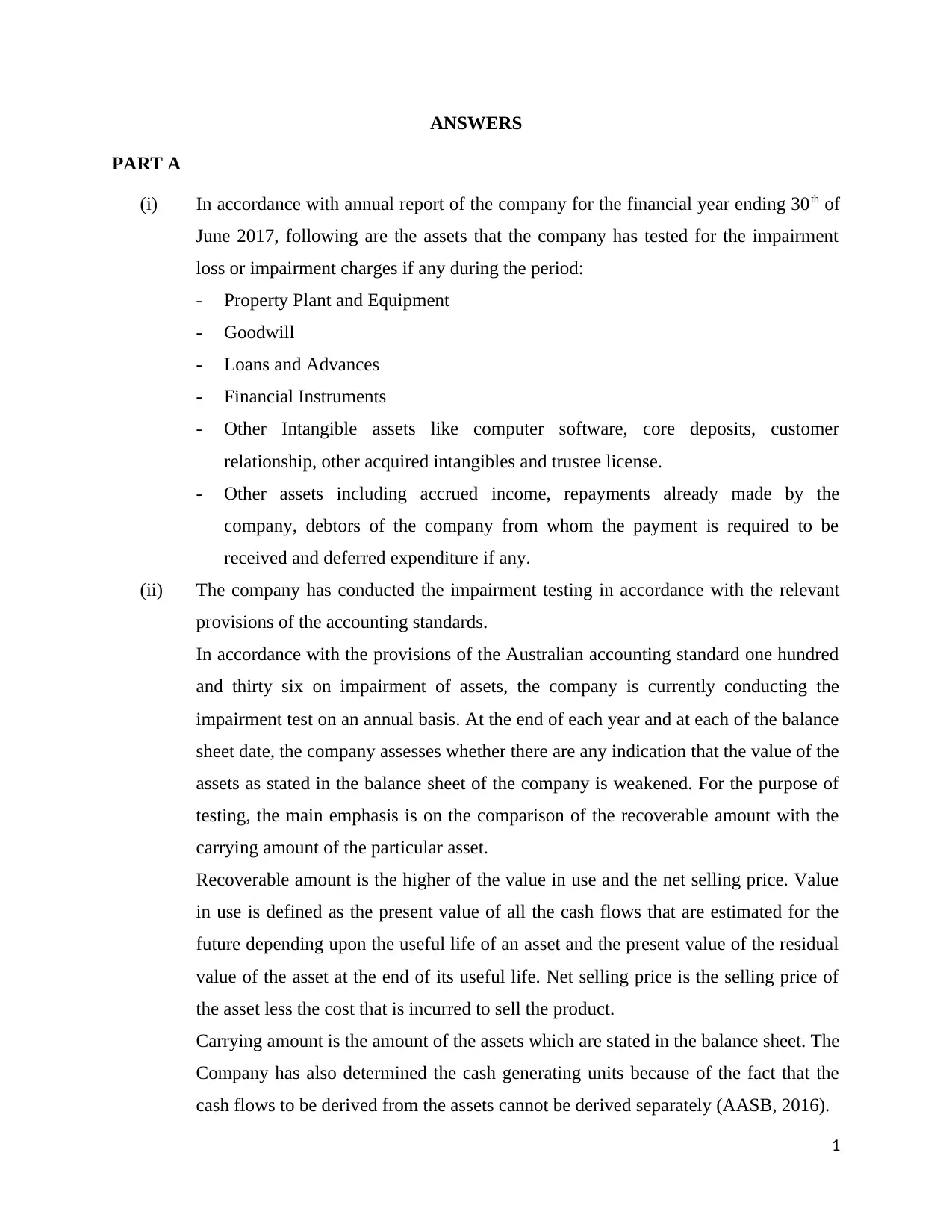
ANSWERS
PART A
(i) In accordance with annual report of the company for the financial year ending 30th of
June 2017, following are the assets that the company has tested for the impairment
loss or impairment charges if any during the period:
- Property Plant and Equipment
- Goodwill
- Loans and Advances
- Financial Instruments
- Other Intangible assets like computer software, core deposits, customer
relationship, other acquired intangibles and trustee license.
- Other assets including accrued income, repayments already made by the
company, debtors of the company from whom the payment is required to be
received and deferred expenditure if any.
(ii) The company has conducted the impairment testing in accordance with the relevant
provisions of the accounting standards.
In accordance with the provisions of the Australian accounting standard one hundred
and thirty six on impairment of assets, the company is currently conducting the
impairment test on an annual basis. At the end of each year and at each of the balance
sheet date, the company assesses whether there are any indication that the value of the
assets as stated in the balance sheet of the company is weakened. For the purpose of
testing, the main emphasis is on the comparison of the recoverable amount with the
carrying amount of the particular asset.
Recoverable amount is the higher of the value in use and the net selling price. Value
in use is defined as the present value of all the cash flows that are estimated for the
future depending upon the useful life of an asset and the present value of the residual
value of the asset at the end of its useful life. Net selling price is the selling price of
the asset less the cost that is incurred to sell the product.
Carrying amount is the amount of the assets which are stated in the balance sheet. The
Company has also determined the cash generating units because of the fact that the
cash flows to be derived from the assets cannot be derived separately (AASB, 2016).
1
PART A
(i) In accordance with annual report of the company for the financial year ending 30th of
June 2017, following are the assets that the company has tested for the impairment
loss or impairment charges if any during the period:
- Property Plant and Equipment
- Goodwill
- Loans and Advances
- Financial Instruments
- Other Intangible assets like computer software, core deposits, customer
relationship, other acquired intangibles and trustee license.
- Other assets including accrued income, repayments already made by the
company, debtors of the company from whom the payment is required to be
received and deferred expenditure if any.
(ii) The company has conducted the impairment testing in accordance with the relevant
provisions of the accounting standards.
In accordance with the provisions of the Australian accounting standard one hundred
and thirty six on impairment of assets, the company is currently conducting the
impairment test on an annual basis. At the end of each year and at each of the balance
sheet date, the company assesses whether there are any indication that the value of the
assets as stated in the balance sheet of the company is weakened. For the purpose of
testing, the main emphasis is on the comparison of the recoverable amount with the
carrying amount of the particular asset.
Recoverable amount is the higher of the value in use and the net selling price. Value
in use is defined as the present value of all the cash flows that are estimated for the
future depending upon the useful life of an asset and the present value of the residual
value of the asset at the end of its useful life. Net selling price is the selling price of
the asset less the cost that is incurred to sell the product.
Carrying amount is the amount of the assets which are stated in the balance sheet. The
Company has also determined the cash generating units because of the fact that the
cash flows to be derived from the assets cannot be derived separately (AASB, 2016).
1
Paraphrase This Document
Need a fresh take? Get an instant paraphrase of this document with our AI Paraphraser
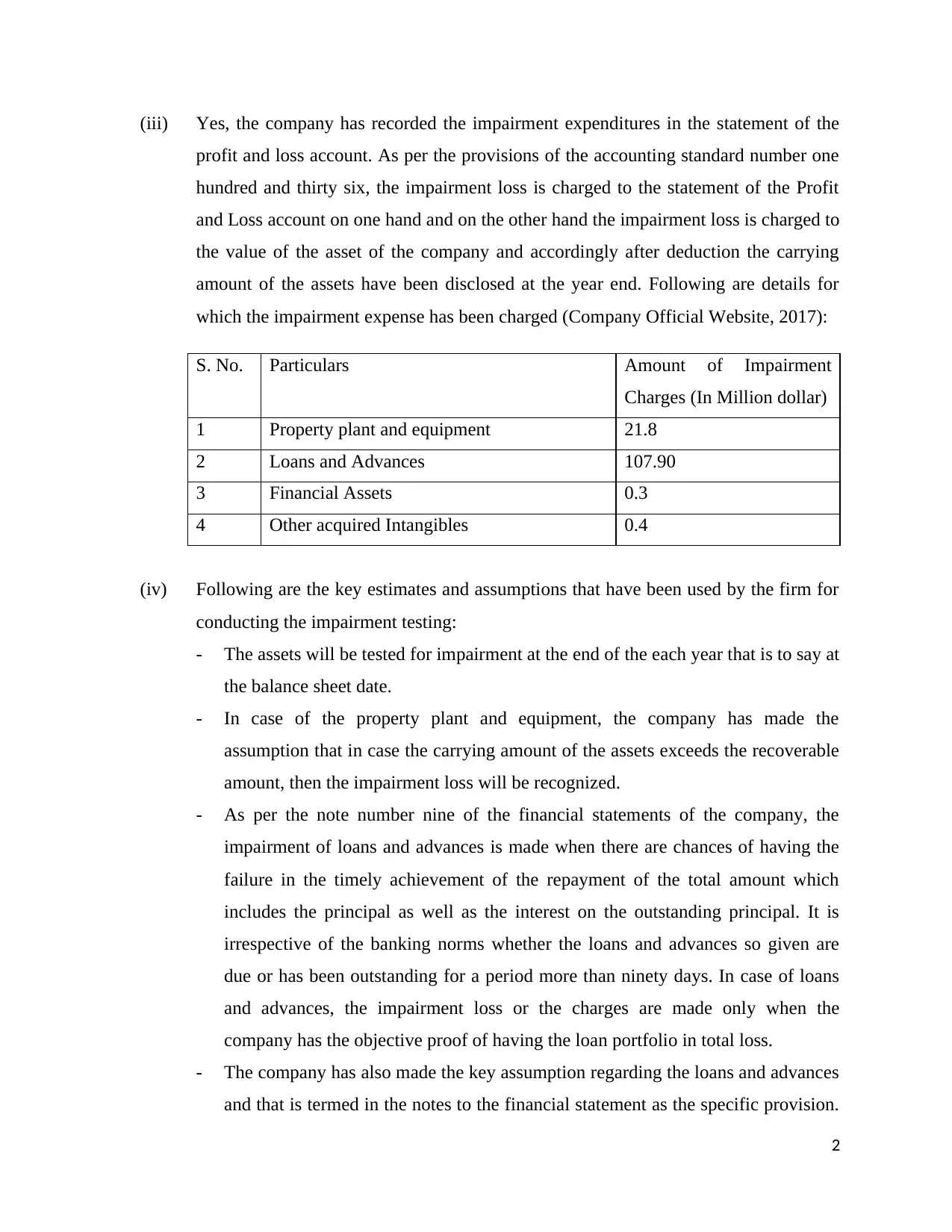
(iii) Yes, the company has recorded the impairment expenditures in the statement of the
profit and loss account. As per the provisions of the accounting standard number one
hundred and thirty six, the impairment loss is charged to the statement of the Profit
and Loss account on one hand and on the other hand the impairment loss is charged to
the value of the asset of the company and accordingly after deduction the carrying
amount of the assets have been disclosed at the year end. Following are details for
which the impairment expense has been charged (Company Official Website, 2017):
S. No. Particulars Amount of Impairment
Charges (In Million dollar)
1 Property plant and equipment 21.8
2 Loans and Advances 107.90
3 Financial Assets 0.3
4 Other acquired Intangibles 0.4
(iv) Following are the key estimates and assumptions that have been used by the firm for
conducting the impairment testing:
- The assets will be tested for impairment at the end of the each year that is to say at
the balance sheet date.
- In case of the property plant and equipment, the company has made the
assumption that in case the carrying amount of the assets exceeds the recoverable
amount, then the impairment loss will be recognized.
- As per the note number nine of the financial statements of the company, the
impairment of loans and advances is made when there are chances of having the
failure in the timely achievement of the repayment of the total amount which
includes the principal as well as the interest on the outstanding principal. It is
irrespective of the banking norms whether the loans and advances so given are
due or has been outstanding for a period more than ninety days. In case of loans
and advances, the impairment loss or the charges are made only when the
company has the objective proof of having the loan portfolio in total loss.
- The company has also made the key assumption regarding the loans and advances
and that is termed in the notes to the financial statement as the specific provision.
2
profit and loss account. As per the provisions of the accounting standard number one
hundred and thirty six, the impairment loss is charged to the statement of the Profit
and Loss account on one hand and on the other hand the impairment loss is charged to
the value of the asset of the company and accordingly after deduction the carrying
amount of the assets have been disclosed at the year end. Following are details for
which the impairment expense has been charged (Company Official Website, 2017):
S. No. Particulars Amount of Impairment
Charges (In Million dollar)
1 Property plant and equipment 21.8
2 Loans and Advances 107.90
3 Financial Assets 0.3
4 Other acquired Intangibles 0.4
(iv) Following are the key estimates and assumptions that have been used by the firm for
conducting the impairment testing:
- The assets will be tested for impairment at the end of the each year that is to say at
the balance sheet date.
- In case of the property plant and equipment, the company has made the
assumption that in case the carrying amount of the assets exceeds the recoverable
amount, then the impairment loss will be recognized.
- As per the note number nine of the financial statements of the company, the
impairment of loans and advances is made when there are chances of having the
failure in the timely achievement of the repayment of the total amount which
includes the principal as well as the interest on the outstanding principal. It is
irrespective of the banking norms whether the loans and advances so given are
due or has been outstanding for a period more than ninety days. In case of loans
and advances, the impairment loss or the charges are made only when the
company has the objective proof of having the loan portfolio in total loss.
- The company has also made the key assumption regarding the loans and advances
and that is termed in the notes to the financial statement as the specific provision.
2
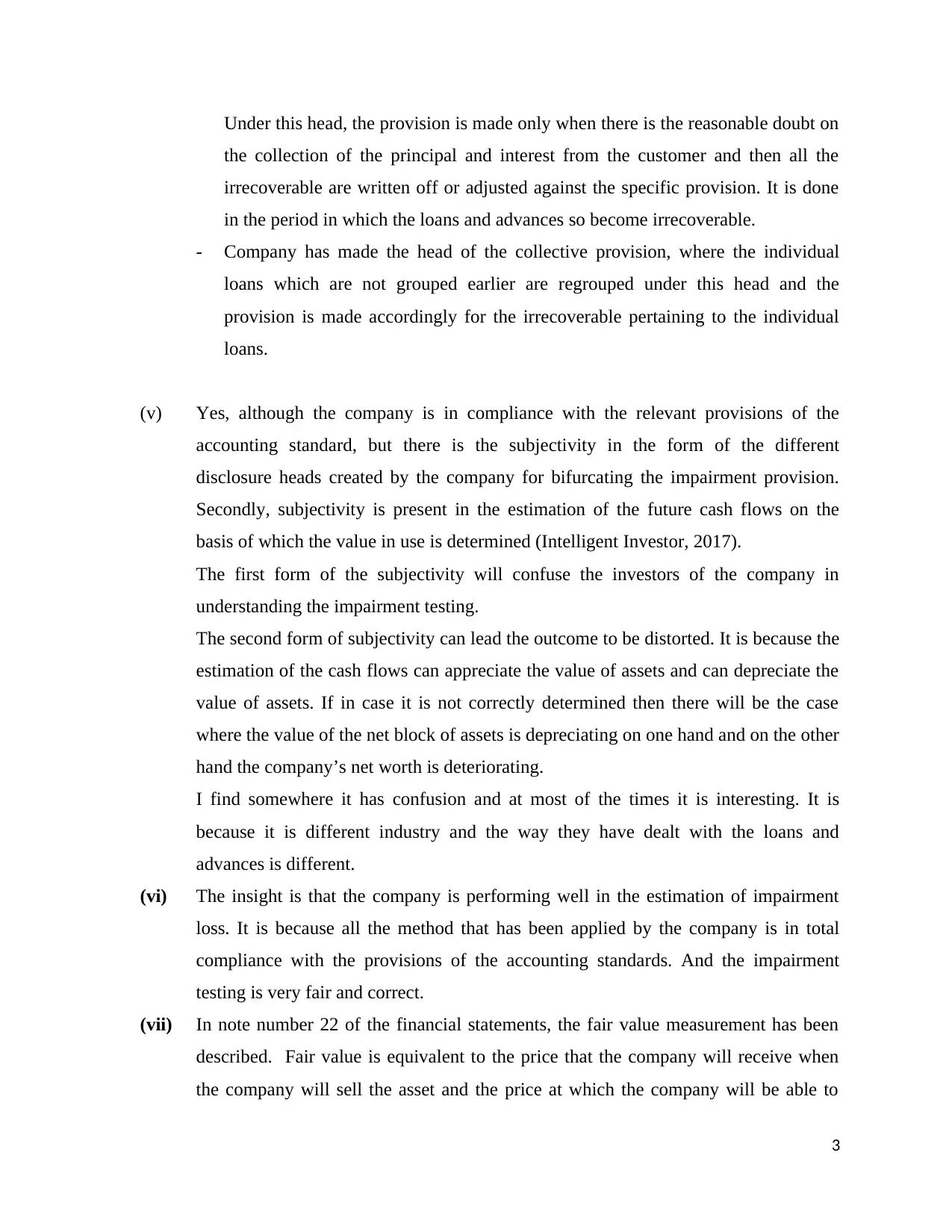
Under this head, the provision is made only when there is the reasonable doubt on
the collection of the principal and interest from the customer and then all the
irrecoverable are written off or adjusted against the specific provision. It is done
in the period in which the loans and advances so become irrecoverable.
- Company has made the head of the collective provision, where the individual
loans which are not grouped earlier are regrouped under this head and the
provision is made accordingly for the irrecoverable pertaining to the individual
loans.
(v) Yes, although the company is in compliance with the relevant provisions of the
accounting standard, but there is the subjectivity in the form of the different
disclosure heads created by the company for bifurcating the impairment provision.
Secondly, subjectivity is present in the estimation of the future cash flows on the
basis of which the value in use is determined (Intelligent Investor, 2017).
The first form of the subjectivity will confuse the investors of the company in
understanding the impairment testing.
The second form of subjectivity can lead the outcome to be distorted. It is because the
estimation of the cash flows can appreciate the value of assets and can depreciate the
value of assets. If in case it is not correctly determined then there will be the case
where the value of the net block of assets is depreciating on one hand and on the other
hand the company’s net worth is deteriorating.
I find somewhere it has confusion and at most of the times it is interesting. It is
because it is different industry and the way they have dealt with the loans and
advances is different.
(vi) The insight is that the company is performing well in the estimation of impairment
loss. It is because all the method that has been applied by the company is in total
compliance with the provisions of the accounting standards. And the impairment
testing is very fair and correct.
(vii) In note number 22 of the financial statements, the fair value measurement has been
described. Fair value is equivalent to the price that the company will receive when
the company will sell the asset and the price at which the company will be able to
3
the collection of the principal and interest from the customer and then all the
irrecoverable are written off or adjusted against the specific provision. It is done
in the period in which the loans and advances so become irrecoverable.
- Company has made the head of the collective provision, where the individual
loans which are not grouped earlier are regrouped under this head and the
provision is made accordingly for the irrecoverable pertaining to the individual
loans.
(v) Yes, although the company is in compliance with the relevant provisions of the
accounting standard, but there is the subjectivity in the form of the different
disclosure heads created by the company for bifurcating the impairment provision.
Secondly, subjectivity is present in the estimation of the future cash flows on the
basis of which the value in use is determined (Intelligent Investor, 2017).
The first form of the subjectivity will confuse the investors of the company in
understanding the impairment testing.
The second form of subjectivity can lead the outcome to be distorted. It is because the
estimation of the cash flows can appreciate the value of assets and can depreciate the
value of assets. If in case it is not correctly determined then there will be the case
where the value of the net block of assets is depreciating on one hand and on the other
hand the company’s net worth is deteriorating.
I find somewhere it has confusion and at most of the times it is interesting. It is
because it is different industry and the way they have dealt with the loans and
advances is different.
(vi) The insight is that the company is performing well in the estimation of impairment
loss. It is because all the method that has been applied by the company is in total
compliance with the provisions of the accounting standards. And the impairment
testing is very fair and correct.
(vii) In note number 22 of the financial statements, the fair value measurement has been
described. Fair value is equivalent to the price that the company will receive when
the company will sell the asset and the price at which the company will be able to
3
⊘ This is a preview!⊘
Do you want full access?
Subscribe today to unlock all pages.

Trusted by 1+ million students worldwide
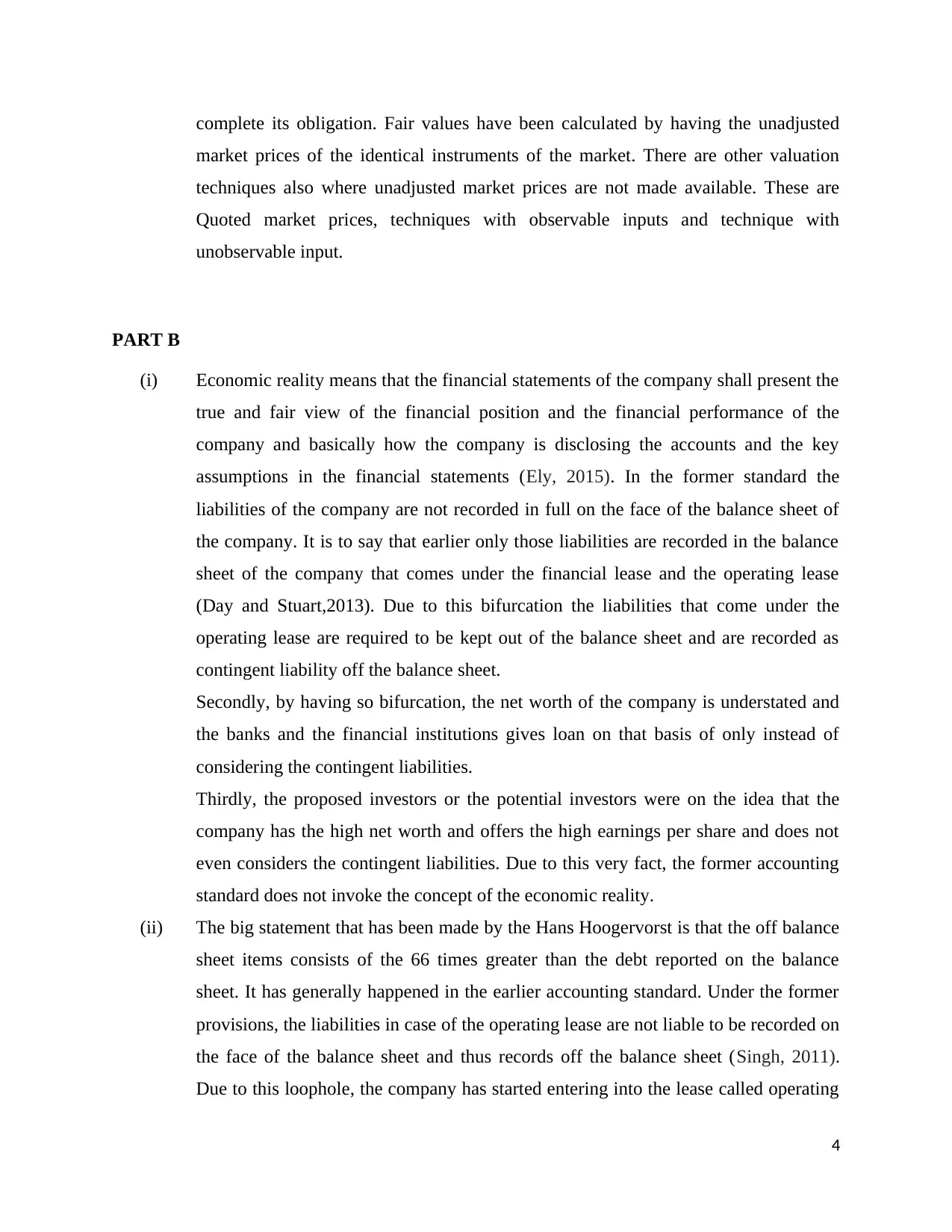
complete its obligation. Fair values have been calculated by having the unadjusted
market prices of the identical instruments of the market. There are other valuation
techniques also where unadjusted market prices are not made available. These are
Quoted market prices, techniques with observable inputs and technique with
unobservable input.
PART B
(i) Economic reality means that the financial statements of the company shall present the
true and fair view of the financial position and the financial performance of the
company and basically how the company is disclosing the accounts and the key
assumptions in the financial statements (Ely, 2015). In the former standard the
liabilities of the company are not recorded in full on the face of the balance sheet of
the company. It is to say that earlier only those liabilities are recorded in the balance
sheet of the company that comes under the financial lease and the operating lease
(Day and Stuart,2013). Due to this bifurcation the liabilities that come under the
operating lease are required to be kept out of the balance sheet and are recorded as
contingent liability off the balance sheet.
Secondly, by having so bifurcation, the net worth of the company is understated and
the banks and the financial institutions gives loan on that basis of only instead of
considering the contingent liabilities.
Thirdly, the proposed investors or the potential investors were on the idea that the
company has the high net worth and offers the high earnings per share and does not
even considers the contingent liabilities. Due to this very fact, the former accounting
standard does not invoke the concept of the economic reality.
(ii) The big statement that has been made by the Hans Hoogervorst is that the off balance
sheet items consists of the 66 times greater than the debt reported on the balance
sheet. It has generally happened in the earlier accounting standard. Under the former
provisions, the liabilities in case of the operating lease are not liable to be recorded on
the face of the balance sheet and thus records off the balance sheet (Singh, 2011).
Due to this loophole, the company has started entering into the lease called operating
4
market prices of the identical instruments of the market. There are other valuation
techniques also where unadjusted market prices are not made available. These are
Quoted market prices, techniques with observable inputs and technique with
unobservable input.
PART B
(i) Economic reality means that the financial statements of the company shall present the
true and fair view of the financial position and the financial performance of the
company and basically how the company is disclosing the accounts and the key
assumptions in the financial statements (Ely, 2015). In the former standard the
liabilities of the company are not recorded in full on the face of the balance sheet of
the company. It is to say that earlier only those liabilities are recorded in the balance
sheet of the company that comes under the financial lease and the operating lease
(Day and Stuart,2013). Due to this bifurcation the liabilities that come under the
operating lease are required to be kept out of the balance sheet and are recorded as
contingent liability off the balance sheet.
Secondly, by having so bifurcation, the net worth of the company is understated and
the banks and the financial institutions gives loan on that basis of only instead of
considering the contingent liabilities.
Thirdly, the proposed investors or the potential investors were on the idea that the
company has the high net worth and offers the high earnings per share and does not
even considers the contingent liabilities. Due to this very fact, the former accounting
standard does not invoke the concept of the economic reality.
(ii) The big statement that has been made by the Hans Hoogervorst is that the off balance
sheet items consists of the 66 times greater than the debt reported on the balance
sheet. It has generally happened in the earlier accounting standard. Under the former
provisions, the liabilities in case of the operating lease are not liable to be recorded on
the face of the balance sheet and thus records off the balance sheet (Singh, 2011).
Due to this loophole, the company has started entering into the lease called operating
4
Paraphrase This Document
Need a fresh take? Get an instant paraphrase of this document with our AI Paraphraser
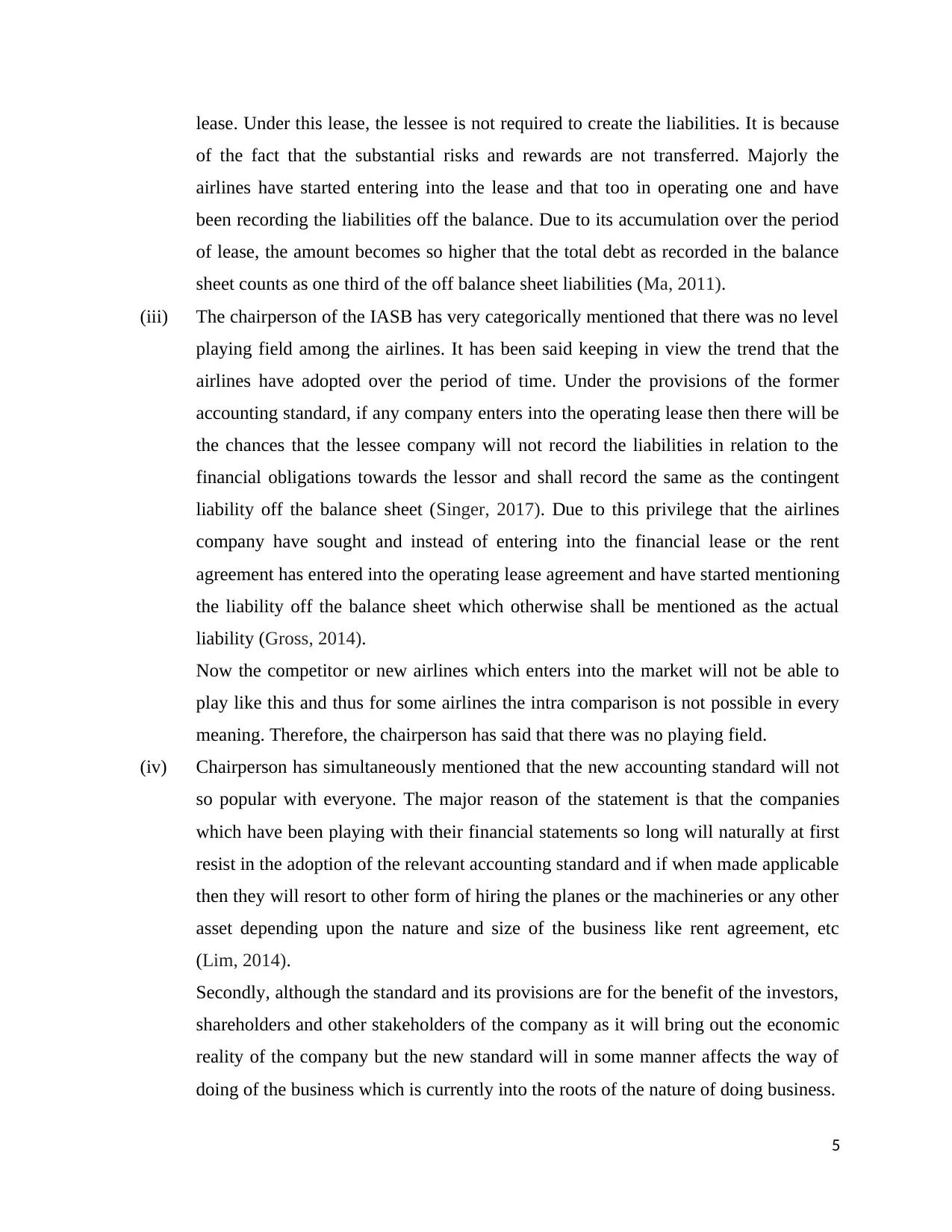
lease. Under this lease, the lessee is not required to create the liabilities. It is because
of the fact that the substantial risks and rewards are not transferred. Majorly the
airlines have started entering into the lease and that too in operating one and have
been recording the liabilities off the balance. Due to its accumulation over the period
of lease, the amount becomes so higher that the total debt as recorded in the balance
sheet counts as one third of the off balance sheet liabilities (Ma, 2011).
(iii) The chairperson of the IASB has very categorically mentioned that there was no level
playing field among the airlines. It has been said keeping in view the trend that the
airlines have adopted over the period of time. Under the provisions of the former
accounting standard, if any company enters into the operating lease then there will be
the chances that the lessee company will not record the liabilities in relation to the
financial obligations towards the lessor and shall record the same as the contingent
liability off the balance sheet (Singer, 2017). Due to this privilege that the airlines
company have sought and instead of entering into the financial lease or the rent
agreement has entered into the operating lease agreement and have started mentioning
the liability off the balance sheet which otherwise shall be mentioned as the actual
liability (Gross, 2014).
Now the competitor or new airlines which enters into the market will not be able to
play like this and thus for some airlines the intra comparison is not possible in every
meaning. Therefore, the chairperson has said that there was no playing field.
(iv) Chairperson has simultaneously mentioned that the new accounting standard will not
so popular with everyone. The major reason of the statement is that the companies
which have been playing with their financial statements so long will naturally at first
resist in the adoption of the relevant accounting standard and if when made applicable
then they will resort to other form of hiring the planes or the machineries or any other
asset depending upon the nature and size of the business like rent agreement, etc
(Lim, 2014).
Secondly, although the standard and its provisions are for the benefit of the investors,
shareholders and other stakeholders of the company as it will bring out the economic
reality of the company but the new standard will in some manner affects the way of
doing of the business which is currently into the roots of the nature of doing business.
5
of the fact that the substantial risks and rewards are not transferred. Majorly the
airlines have started entering into the lease and that too in operating one and have
been recording the liabilities off the balance. Due to its accumulation over the period
of lease, the amount becomes so higher that the total debt as recorded in the balance
sheet counts as one third of the off balance sheet liabilities (Ma, 2011).
(iii) The chairperson of the IASB has very categorically mentioned that there was no level
playing field among the airlines. It has been said keeping in view the trend that the
airlines have adopted over the period of time. Under the provisions of the former
accounting standard, if any company enters into the operating lease then there will be
the chances that the lessee company will not record the liabilities in relation to the
financial obligations towards the lessor and shall record the same as the contingent
liability off the balance sheet (Singer, 2017). Due to this privilege that the airlines
company have sought and instead of entering into the financial lease or the rent
agreement has entered into the operating lease agreement and have started mentioning
the liability off the balance sheet which otherwise shall be mentioned as the actual
liability (Gross, 2014).
Now the competitor or new airlines which enters into the market will not be able to
play like this and thus for some airlines the intra comparison is not possible in every
meaning. Therefore, the chairperson has said that there was no playing field.
(iv) Chairperson has simultaneously mentioned that the new accounting standard will not
so popular with everyone. The major reason of the statement is that the companies
which have been playing with their financial statements so long will naturally at first
resist in the adoption of the relevant accounting standard and if when made applicable
then they will resort to other form of hiring the planes or the machineries or any other
asset depending upon the nature and size of the business like rent agreement, etc
(Lim, 2014).
Secondly, although the standard and its provisions are for the benefit of the investors,
shareholders and other stakeholders of the company as it will bring out the economic
reality of the company but the new standard will in some manner affects the way of
doing of the business which is currently into the roots of the nature of doing business.
5
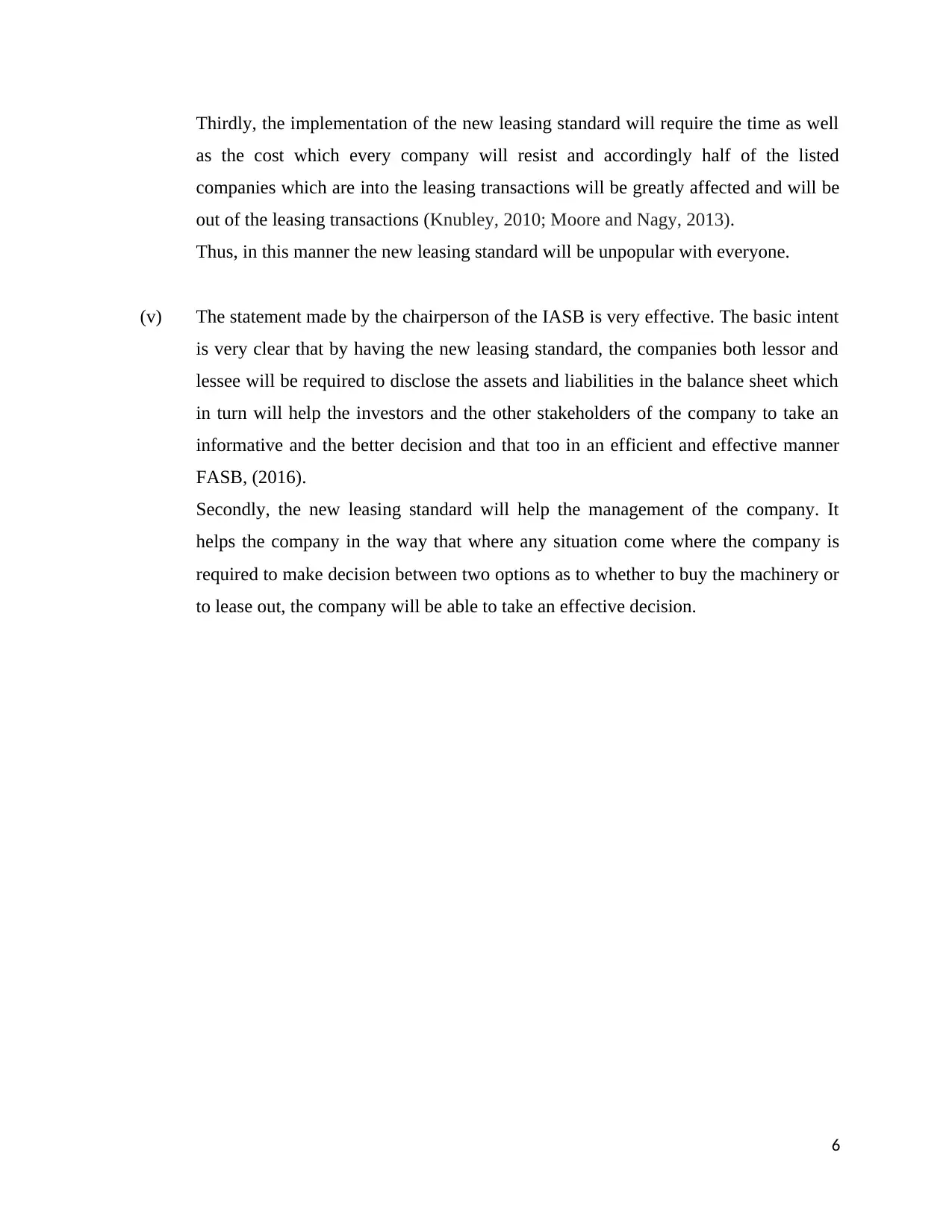
Thirdly, the implementation of the new leasing standard will require the time as well
as the cost which every company will resist and accordingly half of the listed
companies which are into the leasing transactions will be greatly affected and will be
out of the leasing transactions (Knubley, 2010; Moore and Nagy, 2013).
Thus, in this manner the new leasing standard will be unpopular with everyone.
(v) The statement made by the chairperson of the IASB is very effective. The basic intent
is very clear that by having the new leasing standard, the companies both lessor and
lessee will be required to disclose the assets and liabilities in the balance sheet which
in turn will help the investors and the other stakeholders of the company to take an
informative and the better decision and that too in an efficient and effective manner
FASB, (2016).
Secondly, the new leasing standard will help the management of the company. It
helps the company in the way that where any situation come where the company is
required to make decision between two options as to whether to buy the machinery or
to lease out, the company will be able to take an effective decision.
6
as the cost which every company will resist and accordingly half of the listed
companies which are into the leasing transactions will be greatly affected and will be
out of the leasing transactions (Knubley, 2010; Moore and Nagy, 2013).
Thus, in this manner the new leasing standard will be unpopular with everyone.
(v) The statement made by the chairperson of the IASB is very effective. The basic intent
is very clear that by having the new leasing standard, the companies both lessor and
lessee will be required to disclose the assets and liabilities in the balance sheet which
in turn will help the investors and the other stakeholders of the company to take an
informative and the better decision and that too in an efficient and effective manner
FASB, (2016).
Secondly, the new leasing standard will help the management of the company. It
helps the company in the way that where any situation come where the company is
required to make decision between two options as to whether to buy the machinery or
to lease out, the company will be able to take an effective decision.
6
⊘ This is a preview!⊘
Do you want full access?
Subscribe today to unlock all pages.

Trusted by 1+ million students worldwide
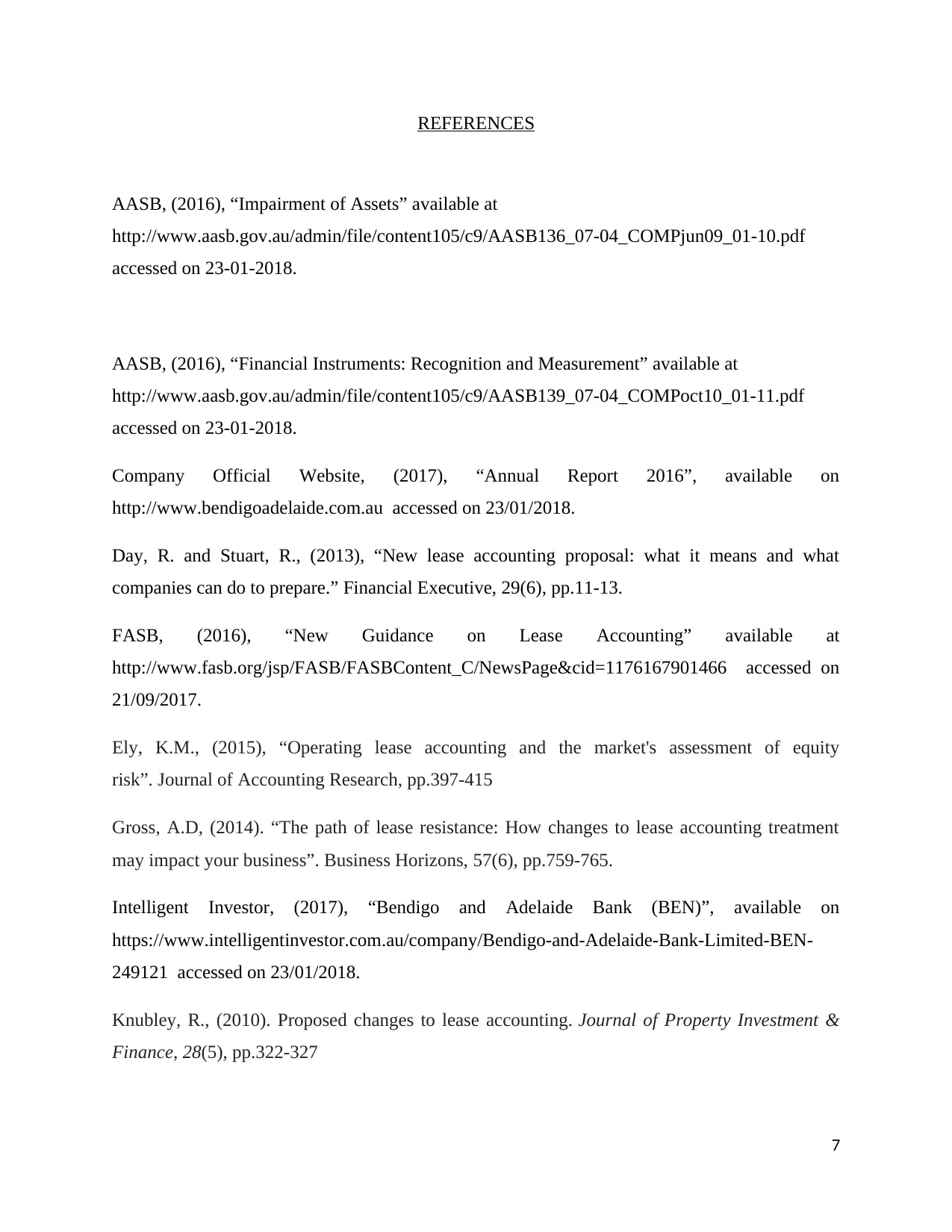
REFERENCES
AASB, (2016), “Impairment of Assets” available at
http://www.aasb.gov.au/admin/file/content105/c9/AASB136_07-04_COMPjun09_01-10.pdf
accessed on 23-01-2018.
AASB, (2016), “Financial Instruments: Recognition and Measurement” available at
http://www.aasb.gov.au/admin/file/content105/c9/AASB139_07-04_COMPoct10_01-11.pdf
accessed on 23-01-2018.
Company Official Website, (2017), “Annual Report 2016”, available on
http://www.bendigoadelaide.com.au accessed on 23/01/2018.
Day, R. and Stuart, R., (2013), “New lease accounting proposal: what it means and what
companies can do to prepare.” Financial Executive, 29(6), pp.11-13.
FASB, (2016), “New Guidance on Lease Accounting” available at
http://www.fasb.org/jsp/FASB/FASBContent_C/NewsPage&cid=1176167901466 accessed on
21/09/2017.
Ely, K.M., (2015), “Operating lease accounting and the market's assessment of equity
risk”. Journal of Accounting Research, pp.397-415
Gross, A.D, (2014). “The path of lease resistance: How changes to lease accounting treatment
may impact your business”. Business Horizons, 57(6), pp.759-765.
Intelligent Investor, (2017), “Bendigo and Adelaide Bank (BEN)”, available on
https://www.intelligentinvestor.com.au/company/Bendigo-and-Adelaide-Bank-Limited-BEN-
249121 accessed on 23/01/2018.
Knubley, R., (2010). Proposed changes to lease accounting. Journal of Property Investment &
Finance, 28(5), pp.322-327
7
AASB, (2016), “Impairment of Assets” available at
http://www.aasb.gov.au/admin/file/content105/c9/AASB136_07-04_COMPjun09_01-10.pdf
accessed on 23-01-2018.
AASB, (2016), “Financial Instruments: Recognition and Measurement” available at
http://www.aasb.gov.au/admin/file/content105/c9/AASB139_07-04_COMPoct10_01-11.pdf
accessed on 23-01-2018.
Company Official Website, (2017), “Annual Report 2016”, available on
http://www.bendigoadelaide.com.au accessed on 23/01/2018.
Day, R. and Stuart, R., (2013), “New lease accounting proposal: what it means and what
companies can do to prepare.” Financial Executive, 29(6), pp.11-13.
FASB, (2016), “New Guidance on Lease Accounting” available at
http://www.fasb.org/jsp/FASB/FASBContent_C/NewsPage&cid=1176167901466 accessed on
21/09/2017.
Ely, K.M., (2015), “Operating lease accounting and the market's assessment of equity
risk”. Journal of Accounting Research, pp.397-415
Gross, A.D, (2014). “The path of lease resistance: How changes to lease accounting treatment
may impact your business”. Business Horizons, 57(6), pp.759-765.
Intelligent Investor, (2017), “Bendigo and Adelaide Bank (BEN)”, available on
https://www.intelligentinvestor.com.au/company/Bendigo-and-Adelaide-Bank-Limited-BEN-
249121 accessed on 23/01/2018.
Knubley, R., (2010). Proposed changes to lease accounting. Journal of Property Investment &
Finance, 28(5), pp.322-327
7
Paraphrase This Document
Need a fresh take? Get an instant paraphrase of this document with our AI Paraphraser
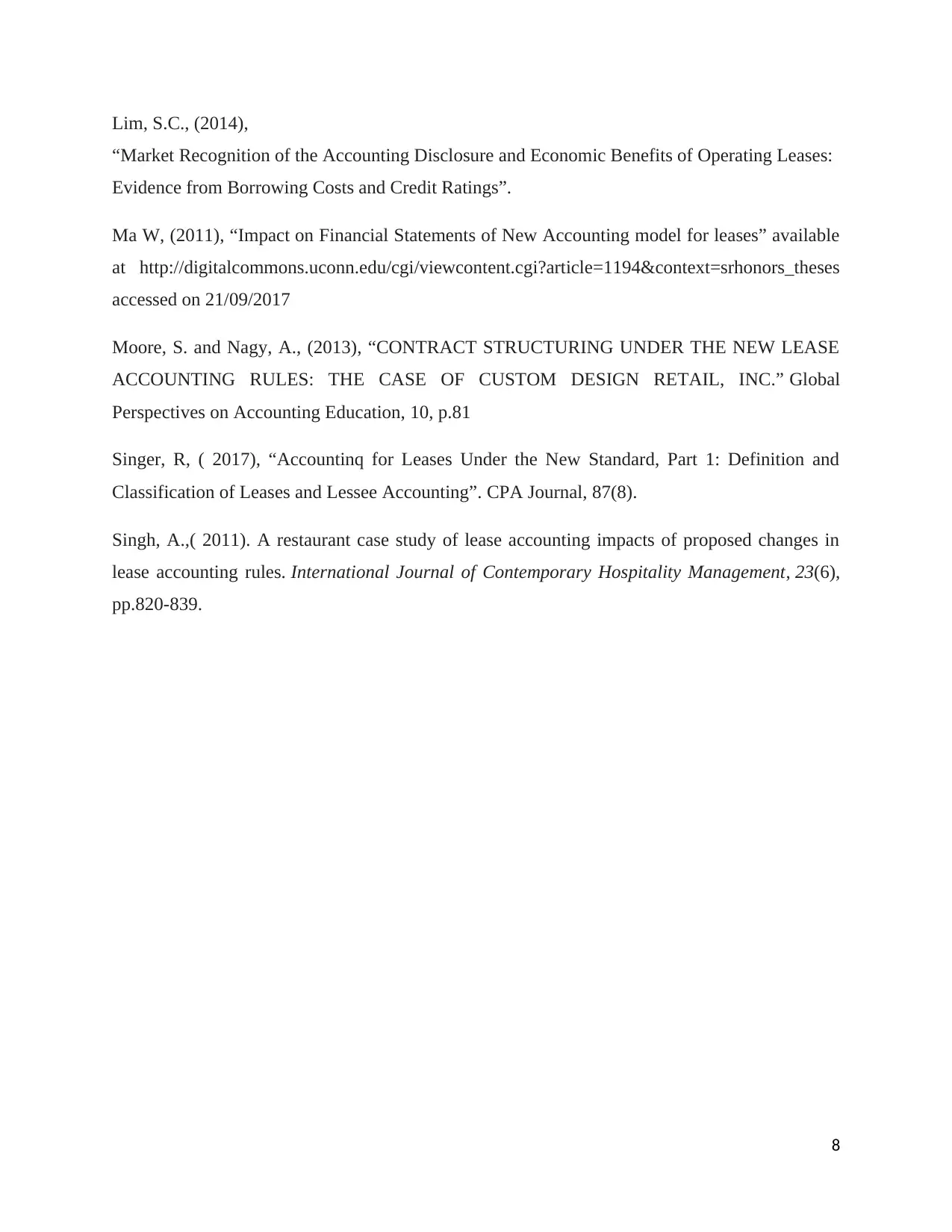
Lim, S.C., (2014),
“Market Recognition of the Accounting Disclosure and Economic Benefits of Operating Leases:
Evidence from Borrowing Costs and Credit Ratings”.
Ma W, (2011), “Impact on Financial Statements of New Accounting model for leases” available
at http://digitalcommons.uconn.edu/cgi/viewcontent.cgi?article=1194&context=srhonors_theses
accessed on 21/09/2017
Moore, S. and Nagy, A., (2013), “CONTRACT STRUCTURING UNDER THE NEW LEASE
ACCOUNTING RULES: THE CASE OF CUSTOM DESIGN RETAIL, INC.” Global
Perspectives on Accounting Education, 10, p.81
Singer, R, ( 2017), “Accountinq for Leases Under the New Standard, Part 1: Definition and
Classification of Leases and Lessee Accounting”. CPA Journal, 87(8).
Singh, A.,( 2011). A restaurant case study of lease accounting impacts of proposed changes in
lease accounting rules. International Journal of Contemporary Hospitality Management, 23(6),
pp.820-839.
8
“Market Recognition of the Accounting Disclosure and Economic Benefits of Operating Leases:
Evidence from Borrowing Costs and Credit Ratings”.
Ma W, (2011), “Impact on Financial Statements of New Accounting model for leases” available
at http://digitalcommons.uconn.edu/cgi/viewcontent.cgi?article=1194&context=srhonors_theses
accessed on 21/09/2017
Moore, S. and Nagy, A., (2013), “CONTRACT STRUCTURING UNDER THE NEW LEASE
ACCOUNTING RULES: THE CASE OF CUSTOM DESIGN RETAIL, INC.” Global
Perspectives on Accounting Education, 10, p.81
Singer, R, ( 2017), “Accountinq for Leases Under the New Standard, Part 1: Definition and
Classification of Leases and Lessee Accounting”. CPA Journal, 87(8).
Singh, A.,( 2011). A restaurant case study of lease accounting impacts of proposed changes in
lease accounting rules. International Journal of Contemporary Hospitality Management, 23(6),
pp.820-839.
8
1 out of 8
Related Documents
Your All-in-One AI-Powered Toolkit for Academic Success.
+13062052269
info@desklib.com
Available 24*7 on WhatsApp / Email
![[object Object]](/_next/static/media/star-bottom.7253800d.svg)
Unlock your academic potential
Copyright © 2020–2025 A2Z Services. All Rights Reserved. Developed and managed by ZUCOL.





